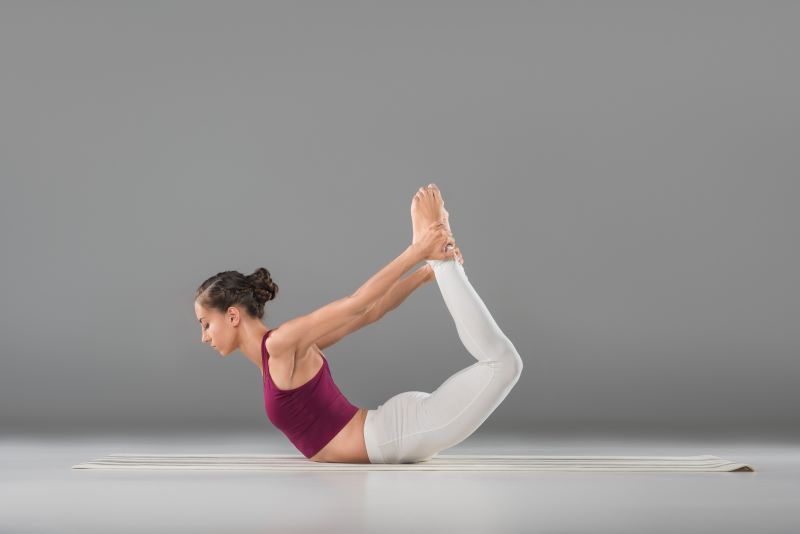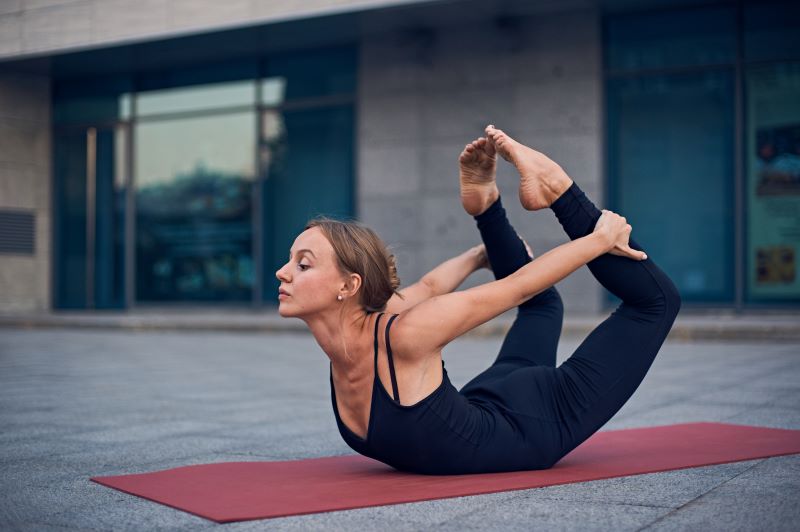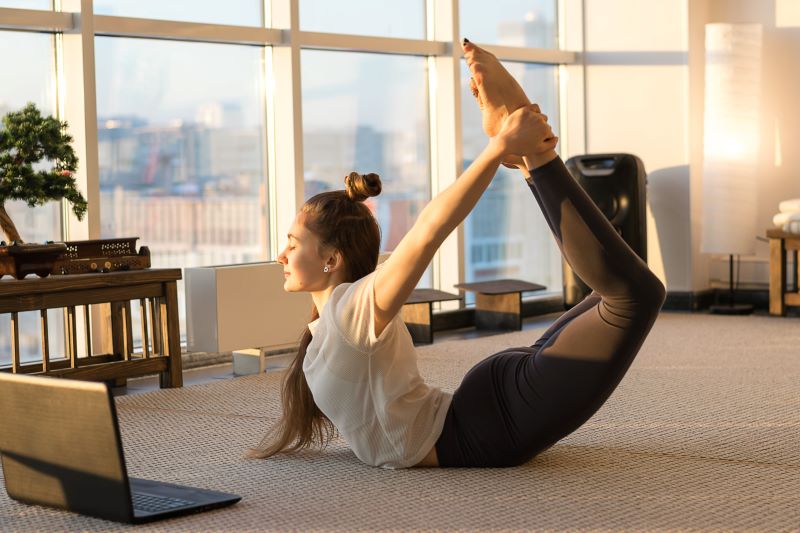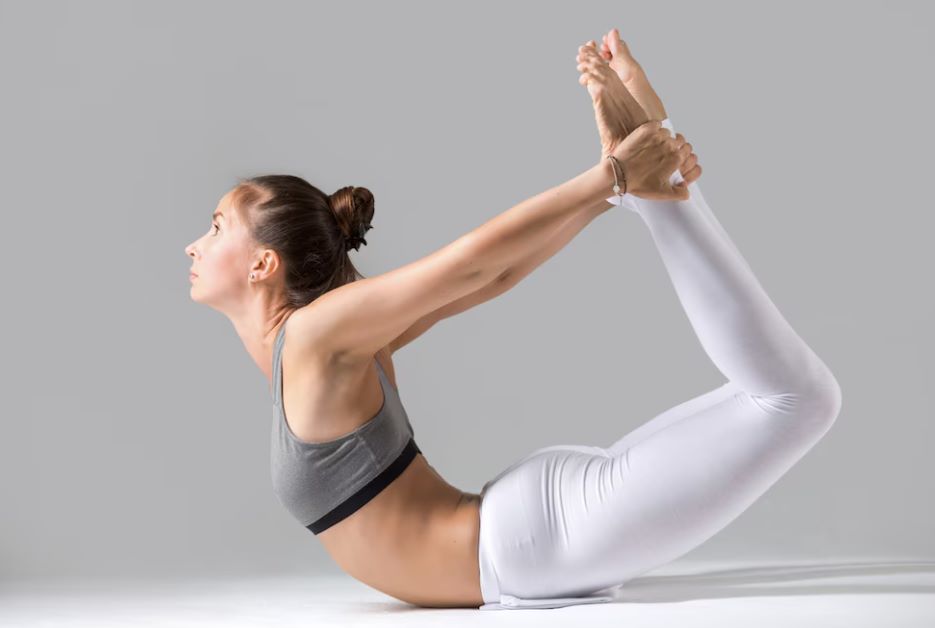14 Health Benefits of Dhanurasana & How to Do It?

Today, most working professionals sit in the same place for hours and remain hunching while working. This is why neck and back pain are commonly found. In addition, many struggle with acute health conditions like constipation, PMS or obesity.
In this case, the benefits of Dhanurasana are far-reaching. This yoga strengthens your back, relieves stress, improves your posture, and has several other benefits.

Table of Contents

What is Dhanurasana (Bow Pose)?
This yoga pose has got its name from a shape it forms when someone performs, that is, a Dhanur or a bow. The focal point of doing this yoga is to work on the muscles in the following areas of your body.
Upper, middle and lower back
Gluteus
Hamstrings
Arms and shoulders
Biceps and triceps
Core
Practising the Dhanurasana pose strengthens your core and also helps treat many ailments. Anyone who has no severe back injury can achieve this posture by practising it regularly. However, you should note that you can do this pose only after a proper warming-up session.
How to Perform Dhanurasana (Bow Pose)?

Before you jump into doing this yoga, wear comfortable clothes and have a yoga mat. You can also do this pose on a carpeted floor. The best thing about performing a Bow Pose is that it requires no fancy set-up.
Here are the step-by-step instructions for performing the Dhanurasana.
Step 1: Lie down on your stomach with your chin up and hands on the sides. The palm should be facing upwards.
Step 2: Bend your knees while exhaling and bring your heels as close as possible to your hips. Keep the knees hip-width apart.
Step 3: Slowly lift your hands, hold your ankle, and keep your toes pointed. If you find it hard to hold your ankles, use an elastic strap.
Step 4: Inhale and lift your body, keeping your head, chest, and thighs off the ground. At this point, only your stomach should touch the floor.
Step 5: Keep your gaze ahead, and do not move your head.
Step 6: Stay in this position for at least 20 seconds.
Step 7: Exhale and gradually rest your legs and chest on the mat.
You can repeat the exercise as per the instructions of your guide.
14 Health Benefits of Dhanurasana
Dhanurasana is known for being a complete yoga asana that strengthens your back and abdominal muscles at the same time. There are many health benefits of doing this yoga; here, a few are listed:
1. Strengthens Back Muscles
The purpose of a Bow Pose is to strengthen your back. Our bodies can naturally bend backwards, but in our daily lifestyle, there is hardly any instance when we consciously bend our bodies at the back. Hence, by doing Dhanurasana, we can improve flexibility and cure back pain.
2. Improves Digestion
Regularly executing this posture stimulates the organs involved in digestive functions. This eventually ensures better functioning of the kidney, liver, pancreas, and intestines and cures bloating, constipation, IBS, etc.
3. Tones Legs and Arm Muscles
This is an ideal exercise if you are looking for effective ways to tone your legs and arms without lifting weights. While doing Dhanurasana, you stretch the hamstring and the muscles in your arms, allowing you to attain the perfect toned legs and arms.
4. Relieves Stress
Unlike high-intensity workouts, yoga more efficiently relieves muscle stress. The Bow Pose is one such yoga pose that has proven beneficial to those suffering from stiff back or shoulder muscles. This happens because muscle stretching encourages improved blood circulation, which soothes stress.
5. Prevents Cardiovascular Risks
Doing Dhanurasana correctly will open up your rigid chest muscles. Hence, it enables better blood circulation throughout the internal system. This, in the long run, positively affects heart risk prevention.
6. Enhances Posture
People often forget to maintain their posture while doing regular activities like sitting or walking. This eventually hampers the condition of your spine and its related muscles. So, practising the Bow Pose is advised to improve your spine flexibility. In addition, this exercise prevents slip discs and other related conditions.
7. Regulates Menstruation
Dhanurasana is one of the basic hatha yoga poses. Although the primary purpose of this exercise is to improve flexibility, it is also known to relieve menstrual irregularities.
8. Helps in Treating Asthma
Besides stimulating and strengthening the chest muscles, the Bow Pose also prevents respiratory problems. Therefore, those who suffer from asthma or COPD can try the pose for some relief. Nonetheless, you must also remember that doing this yoga will not completely cure the disease but provide you with some additional benefits.
9. Cures Obesity
No particular yoga pose can cure obesity. Nevertheless, you can add specific yoga poses, like Dhanurasana, to your routine exercises. This will speed up the process of curing ailments like obesity.
10. Treats Rheumatism
Rheumatism affects the joints, ligaments and muscles, causing immense pain in these regions. Hence, if you discover any early signs of arthritis-like joint pain and weaker immunity, try doing the Bow Pose. It will stretch the necessary muscles and alleviate the pain.
11. Toughen the Core
One of the essential benefits of Dhanurasana is that it toughens the core muscles. This eases body movements and also improves flexibility in other workouts.
12. Remedy for Gastrointestinal Problems
As already mentioned, this yoga is good for the abdominal organs. So, we can infer that Bow Pose can be a cure for gastrointestinal problems. This is because every organ involved in the gastrointestinal system gets stretched during the Bow Pose.
13. Makes Ankles, Thighs, and Abdominal Organs Strong
Other health benefits of the Bow Pose include strengthening all the related body parts and organs. This is inclusive of the ankles, thighs, groyne, abdomen and abdominal organs.
14. Improves Flexibility
Regular practice increases flexibility in the spine, shoulders, and hips. The Dhanurasana pose ensures complete flexibility in the arms and abdominal region.
Types of Dhanurasana
Dhanurasana is a famous yoga pose that resembles an archer's bow. There are various types of Dhanurasana, each with its variations and benefits.
1. Ardha Dhanurasana (Half Bow Pose)
In this variation, only one leg is lifted while the other remains grounded. This variation allows for a deeper stretch in the lifted leg's quadriceps and hip flexors while strengthening the back muscles. Ardha Dhanurasana is an excellent option for beginners or those with limited flexibility.
2. Eka Pada Dhanurasana (One-Legged Bow Pose)

In this variation, one leg is lifted while the opposite arm reaches back to hold the ankle. Eka Pada Dhanurasana provides a deep stretch for the quadriceps, hip flexors, and shoulders of the lifted leg while also strengthening the back muscles and improving balance.
3. Paripurna Dhanurasana (Full Bow Pose)

Lie on your belly, knees bent, and reach back to grab your ankles. Lift your chest and thighs off the ground, pressing your feet back and gazing slightly up. Paripurna Dhanurasana opens the entire front side of the body while strengthening the back muscles.
Things to Know Before Doing Dhanurasana Yoga
Dhanurasana requires some prep before attempting it. Here are some essential things to know before attempting Dhanurasana in yoga:
- Warm-up the Body: Before attempting Dhanurasana, it's crucial to warm up the body properly. Engage in some gentle stretches for the back, shoulders, chest, hips, and thighs to prepare the muscles and joints for the deeper stretch and backbend of the pose.
- Consult a Physician: If you have any existing medical conditions, mainly related to the spine, back, or neck, it's advisable to consult a physician or a qualified yoga instructor before attempting Dhanurasana. Certain health issues may require modifications or avoidance of specific yoga poses.
- Practice Regularly: Dhanurasana requires strength, flexibility, and balance. It's essential to build up these qualities gradually through regular yoga practice. Start with simpler backbends and preparatory poses before progressing to Dhanurasana.
- Listen to Your Body: Pay close attention to how your body feels during the practice. Avoid forcing yourself into the pose or pushing beyond your limits. Honour your body's signals and respect its boundaries to prevent injury.
- Modify as Needed: Dhanurasana can be modified and varied to accommodate different body types and levels of flexibility. Props such as yoga blocks or straps can support the practice and make the pose more accessible.
- Breathe Deeply: Focus on deep, steady breathing throughout the pose. Inhale deeply to expand the chest, lift the torso, and exhale slowly to release tension and deepen the stretch. Smooth, controlled breathing will help you relax into the pose and maintain awareness of your body.
- Avoid Overarching the Neck: In Dhanurasana, keep the neck in a neutral position to avoid compressing the cervical spine. Gaze softly forward or slightly upward, maintaining a lengthened neck and avoiding excessive strain on the muscles or vertebrae.
- Use Proper Alignment: Pay attention to alignment cues from a qualified yoga instructor or trusted resource. Distribute the weight evenly between the abdomen, pelvis, and legs to avoid putting excessive strain on any one area of the body.
- Cool Down After Practice: After completing Dhanurasana or any yoga practice, cool down the body with gentle stretches and relaxation poses. This helps to release any tension built up during the training and promotes a sense of calm and well-being.
How Long to Hold Dhanurasana Pose?
The duration of holding a Dhanurasana pose can vary. Here's how long beginners, intermediate-level practitioners, and advanced practitioners can aim to hold Dhanurasana:
- Beginners: Beginners should hold Dhanurasana for a shorter duration to avoid strain and allow the body to adapt to the pose gradually. Aim to hold the pose for about 15 to 30 seconds initially.
- Intermediate-Level Practitioners: Intermediate-level practitioners can aim to hold Dhanurasana for a longer duration, typically between 30 seconds to 1 minute. With consistent practice, you can gradually extend the hold to 1 minute.
- Advanced Practitioners: Advanced practitioners can hold Dhanurasana for an extended duration, ranging from 1 minute to 2 minutes or more. They have developed greater strength, flexibility, and endurance to sustain challenging poses for longer periods.
Practise regularly to become comfortable with this pose. However, always respect your body's limits and avoid pushing into discomfort or strain.
Risks of Overdoing Dhanurasana
Although there are many benefits to performing Dhanurasana regularly, a few risks are involved if done incorrectly. Here are some risks associated with overdoing Dhanurasana:
- Lower Back Strain: Overdoing Dhanurasana can strain the muscles and ligaments of the lower back, leading to discomfort, stiffness, or even injury.
- Neck and Shoulder Tension: Excessive back arching in Dhanurasana can lead to tension or strain in the neck and shoulders, which can cause stiffness.
- Compression of the Spine: Overdoing Dhanurasana can compress the spinal vertebrae, particularly in the lumbar region, pressurising the intervertebral discs and nerves.
- Hip Flexor Tightness: While Dhanurasana stretches the front of the body, including the hip flexors, overdoing the pose can lead to excessive tightness in these muscles.
- Breathing Difficulties: Holding Dhanurasana for too long or pushing beyond your limits can compromise your ability to breathe deeply and comfortably.
- The strain on the Wrist Joints: In Dhanurasana, overdoing the pose without proper wrist alignment and support can lead to discomfort, strain, or potential wrist injuries.
- Impact on Digestive Organs: Compressing the abdomen in Dhanurasana can impact the functioning of the digestive organs and interfere with digestion.
To support healthy digestion during the pose, it's important to maintain a moderate level of engagement in the core muscles without overly compressing the abdomen.
What are the Tips for Practising Dhanurasana?
As you now know all the Dhanurasana steps, here are some tips to follow:
If you are a beginner, you must know the correct procedure before you do the exercise. Then, you can either enrol in a yoga class or watch or read a proper tutorial.
Always do a warm-up and cool-down session before and after doing the exercises.
Avoid doing Dhanurasana or any yoga immediately after a meal.
Bend backwards as much as possible, but keep the muscles manageable while doing this yoga.
Be mindful of your breathing. Inhale while lifting your body and exhale when resting. In between the two processes, continue breathing at standard intervals.
What are the Precautions and Contraindications of the Bow Pose?
To get all the benefits from Dhanurasana, you must remember the precautions and contraindications.
Refrain from doing this yoga if you have any injuries in the back or neck.
Avoid doing this exercise if you have recently undergone surgery, especially in the abdominal area.
Those who have long-term health conditions like high or low blood pressure, ulcers, migraine, or hernia should also avoid doing this asana.
Do not do this exercise when you are pregnant.
Do not stretch your back unnecessarily.
Who Should Avoid Doing Dhanurasana?
To avail yourself of the complete benefit of Dhanurasana, it's essential to do it every day correctly. However, here are some individuals who should avoid doing Dhanurasana:
- Recent Injuries: Individuals who have recently experienced injuries to the back, neck, shoulders, hips, or knees should avoid Dhanurasana. Performing the pose could increase existing injuries or delay the healing process.
- Chronic Back Pain: People with chronic back pain or conditions such as herniated discs, spinal stenosis, or spondylolisthesis should avoid Dhanurasana. The deep backbend of the pose can place excessive strain on the spine.
- Pregnant Women: Pregnant women, especially those in the later stages of pregnancy, should avoid Dhanurasana. The intense stretching and pressure on the abdomen can be uncomfortable and potentially harmful to both the mother and the fetus.
- High Blood Pressure: Individuals with uncontrolled high blood pressure should avoid Dhanurasana, as the pose can temporarily increase blood pressure levels. Holding the pose for an extended period may increase hypertension and pose risks to cardiovascular health.
- Recent Abdominal Surgery: People who have recently had abdominal surgery, such as hernia repair or abdominal organ surgery, should avoid Dhanurasana. The pressure on the abdomen and internal organs could interfere with healing.
- Osteoporosis: Individuals with osteoporosis or low bone density should avoid deep backbends like Dhanurasana, as they increase the risk of spinal fractures or compression fractures. Instead, focus on gentle poses that support bone health without risking injury.
- Glaucoma: People with glaucoma, a condition characterised by increased pressure within the eyeball, should avoid inverted poses like Dhanurasana. These poses can further elevate intraocular pressure, potentially worsening the condition.
- Severe Joint Pain: Individuals experiencing severe joint pain, particularly in their wrists, elbows, shoulders, hips, or knees, should avoid Dhanurasana. The pose requires joint mobility and stability, which could increase pain and discomfort in the affected areas.
It is better to have health insurance in advance to cover the cost of treatment incurred during an emergency related to Dhanurasana. Also, performing Dhanurasana under a specialised trainer or doctor is recommended to avoid injuries.
What are the Easy Modifications of a Dhanurasana?

If you are a beginner and the Bow Pose is challenging for you, you can first try these alternative ways and then move on to the original pose.
- Using a Yoga Strap: This can help you reach your ankles easily.
- Take a Blanket: If the pressure in the abdominal region feels uncomfortable, place a blanket below your pelvic and lower abdomen for support.
- Ask for Help: Ask for your instructor's help or request any of your family members to help stretch the arms and hold the ankles.
- Practice on a Mattress: It is suggested to start practising Dhanurasana yoga on a plain mattress before doing it on the yoga mat. The cushioned effect will support and bring lesser pressure to the thighs and abs.
Dhanurasana offers numerous health benefits, including improved digestion, strengthened back muscles, and enhanced flexibility. Regularly practising this yoga pose with proper guidance allows individuals to experience these advantages and promote their overall well-being. Incorporating Dhanurasana into one's routine can contribute to a healthier lifestyle and increased vitality.














